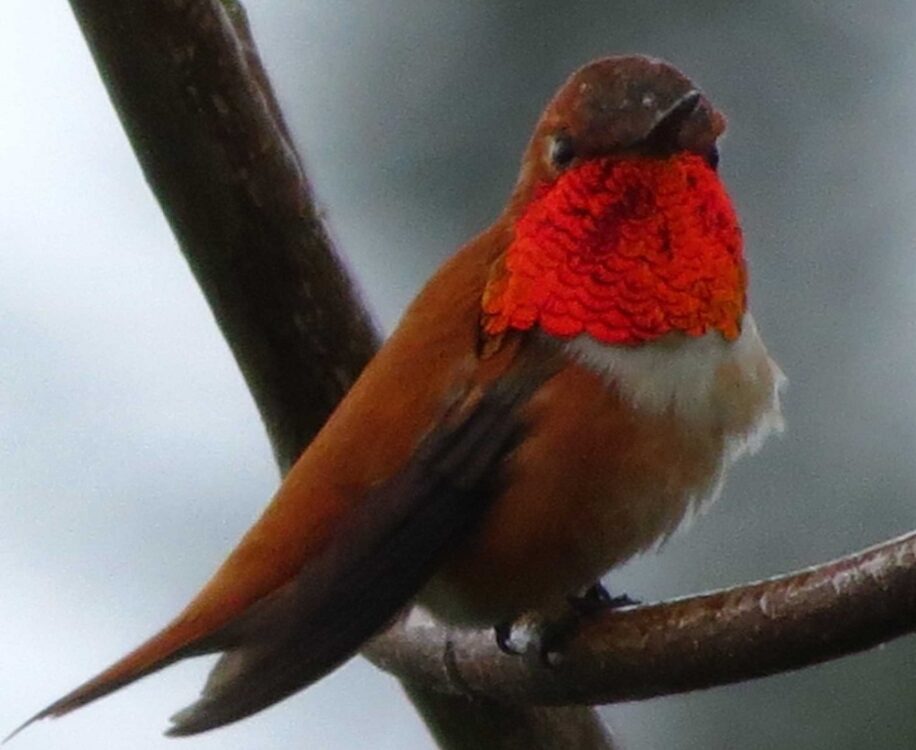The rufous hummingbird is quite honestly one of the most entertaining birds to observe at our feeders. We have hundreds return each year to our feeders. We get so many that I can stand beside a feeder, hold out my arm and they will land all over it taking turns going back and forth to the feeder.
The females are a little larger than the males which are a bit smaller. They are very pretty and people often comment about the display of amazing colors that they offer. They are a bronze colour in many areas including the belly. That part is also white and the two colors contrast very nicely with each other.
The tail is a dark colour with the same bronze as on the back. They have wings that are black at the tips and then bronze as you get closer to the body. Sometimes that area of their body will show and other times they will be hiding it. They also have some white around their throat. The bill is long, slender and black.
Most experts believe that hummingbirds have been around for millions of years. They believe that they evolved from larger birds that grew smaller in order to survive on less food.

The rufous hummingbird is one of the most aggressive of all species of Hummingbirds. They are well known for chasing each other out of their perceived territory. These birds are serious about protecting where they are going to live and where they are going to eat. Even when they aren’t eating themselves they will carefully monitor their feeding areas, you can see them sitting on a branch, close to the feeder with their heads going back and forth looking for others. If they notice any hummingbirds that seem to be taking an interest in doing the same thing they will quickly try to drive them away.
They will also take on wasps, bees, and any other creatures that are known to consume nectar. They don’t want to run the risk that by sharing those supplies they won’t have enough for themselves later on.
The rufous hummingbirds have one of the longest migration routes of any bird. Some of them go for more than 2,000 miles and that is only one way. They have to be very strong and well-fed in order to be able to make it this type of distance annually.
The winter months for this species of hummingbird take them to Mexico and Panama. Just getting across the Gulf of Mexico is an 800-kilometre journey that they are able to do without stopping. That is certainly quite remarkable, especially when you take their small size into consideration. These hummingbirds are able to live in areas that others don’t. They seem to be able to adapt very well to just about any location too. They live in areas out there all over the world.
They tend to stick to areas such as coniferous forests and where there are shrubs. They are fine living in regions close to humans and where humans have altered their natural habitat. As long as they can find a place to sleep, safety from predators, and plenty to eat they will do very well. In fact, in some public places including parks, it is the very presence of the rufous hummingbird that draws people to the area.

Sugar and protein are the diet elements of this hummingbird, just like all other species. They get the sugar that they need from the nectar in plants. They also consume insects. They feed many times a day but only for a period of time that is less than 1 minute. They tend to need to consume up to 3 times their own body weight per day.
While the mating process is very spectacular for most species of hummingbirds, that isn’t the case for this one. The males will engage in some courting rituals including chirping and diving but it is less of a show than with other species. Mating and migrating are really the only times when they will interact with each other.
The males will go around and find as many females to mate with as they possibly can. The females will start looking for a place to put a nest after mating. They instinctively know that if they don’t find a place that is safe, that is close to food, and that offers protection their young won’t survive.
She will likely have two eggs. She will wait for them to hatch about 14 days later. When the temperatures are warm they can hatch in about 10 days. The young depend on their mother for warmth, food, and comfort. They learn how to fly within about a week but they won’t be strong enough yet to fly away and care for themselves. That will take a few more weeks.